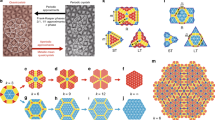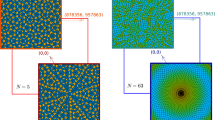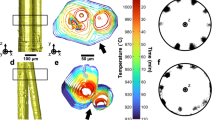Abstract
The atomic structure of quasicrystals1 — solids with long-range order, but non-periodic atomic lattice structure — is often described as the three-dimensional generalization of the planar two-tile Penrose pattern2. Recently, an alternative model has been proposed3,4,5 that describes such structures in terms of a single repeating unit3,4,5 — the three-dimensional generalization of a pattern composed of identical decagons. This model is similar in concept to the unit-cell description of periodic crystals, with the decagon playing the role of a ‘quasi-unit cell’. But, unlike the unit cells in periodic crystals, these quasi-unit cells overlap their neighbours, in the sense that they share atoms. Nevertheless, the basic concept of unit cells in both periodic crystals and quasicrystals is essentially the same: solving the entire atomic structure of the solid reduces to determining the distribution of atoms in the unit cell. Here we report experimental evidence for the quasi-unit-cell model by solving the structure of the decagonal quasicrystal Al72Ni20Co8. The resulting structure is consistent with images obtained by electron and X-ray diffraction, and agrees with the measured stoichiometry, density and symmetry of the compound. The quasi-unit-cell model provides a significantly better fit to these results than all previous alternative models, including Penrose tiling.
This is a preview of subscription content, access via your institution
Access options
Subscribe to this journal
Receive 51 print issues and online access
$199.00 per year
only $3.90 per issue
Buy this article
- Purchase on Springer Link
- Instant access to full article PDF
Prices may be subject to local taxes which are calculated during checkout




Similar content being viewed by others
References
Levine, D. & Steinhardt, P. J. Quasicrystals: a new class of ordered structures. Phys. Rev. Lett. 53, 2477–2480 (1984).
Penrose, R. The role of aesthetics in pure and applied mathematical research. Bull. Inst. Math. Applic. 10, 266–271 (1974).
Gummelt, P. Construction of Penrose tilings by a single aperiodic protoset. Geometriae Dedicata 62, 1–17 (1996).
Steinhardt, P. J. & Jeong, H.-C. Asimpler approach to Penrose tiling with implications for quasicrystal formation. Nature 382, 433–435 (1996).
Jeong, H.-C. & Steinhardt, P. J. Constructing Penrose-like tilings from a single proto-tile and the implications for quasicrystals. Phys. Rev. B 55, 3520–3532 (1997).
Janot, C. & de Boisseau, M. in Quasicrystals: The State of the Art(eds DiVincenzo, D. & Steinhardt, P.J.) 57–94 (World Scientific, Singapore, (1995)).
Tsai, A. P., Inoue, A. & Masumoto, T. Icosahedral, decagonal and amorphous phases in Al–Cu–M (M = transition metal) systems. Mater. Trans. Jpn Inst. Metals 30, 666–676 (1989).
Hiraga, K., Lincoln, F. J. & Sun, W. Structure and structural change of Al–Ni–Co decagonal quasicrystal by high-resolution electron microscopy. Mater. Trans. Jpn Inst. Metals 32, 308–314 (1991).
Yamamoto, A. Structure of decagonal Al65Cu20Co15quasicrystals. Sci. Rep. Res. Inst. Tohoku Univ. A 42, 207–212 (1996).
Ritsch, S.et al. Highly perfect decagonal Al–Co–Ni quasicrystals. Phil. Mag A 74, 99–106 (1996).
Burkov, S. Modeling decagonal quasicrystals: random assembly of interpenetrating decagonal clusters. J. Phys. 2, 695–706 (1992); Structure model of the Al–Cu–Co decagonal quasicrystal. Phys. Rev. Lett. 67, 614–617 (1991).
Steurer, W. & Kuo, K. H. Five-dimensional structure analysis of decagonal Al65Cu20Co15. Acta Crystallogr. B 46, 703–712 (1990).
Boudard, M.et al. Atomic structure of the Al–Pd–Mn icosahedral phase. J. Non-Cryst. Solids 153–4;5–9 (1993).
Janot, C. & Patera, J. Simple physical generation of quasicrystals. Phys. Lett. A 233, 110–114 (1997).
Edagawa, K., Ichihara, M., Suzuki, K. & Takeuchi, S. New type of decagonal quasicrystal with superlattice order in Al–Ni–Co alloy. Phil. Mag. Lett. 66, 19–25 (1992).
Ritsch, S., Beeli, C., Nissen, H.-U. & Luck, R. Two different superstructures od the decagonal Al–Co–Ni quasicrystal. Phil. Mag. A 71, 671–685 (1995).
Fujiwara, A., Tsai, A. P. & Inoue, A. in Proc. 6th Int. Conf. Quasicrystals(eds Takeuchi, S. & Fujiwara, A.) 341 (World Scientific, Singapore, (1988)).
Saitoh, K., Tsuda, K., Tanaka, M., Kaneko, K. & Tsai, A. P. Structural study of an Al72Cu20Co8decagonal quasicrystal using the high-angle annular dark-field method. Jpn J. Appl. Phys. 36, L1400–L1402 (1997).
Saitoh, K., Tsuda, K. & Tanaka, M. Anew structural model of an Al72Ni20Co8decagonal quasicrystal.Preprint (Tohoku Univ., (1998)); J. Phys. Soc. Jpn.(in the press).
Beeli, C. & Horiuchi, S. The structure and its reconstruction in the decagonal Cl70Cu17Co13. Phil. Mag B 70, 215–240 (1994).
Sato, T. J., Abe, E. & Tsai, A. P. Anovel decagonal quasicrystal in Zn–Mg–Dy system. Jpn J. Appl. Phys. 36, L1038–L1039 (1997).
Mermin, N. D. in Quasicrystals: The State of the Art(eds DiVincenzo, D. & Steinhardt, P. J.) 133–184 (World Scientific, Singapore, (1991)).
Acknowledgements
We thank R. Kilaas of Total Resolution, Inc. for lending us the MacTempas software package for this project. This work was partially supported by the US Department of Energy at Princeton, and by CREST (Core Research for Evolutional Science and Technology) of Japan Science and Technology Corporation (JST).
Author information
Authors and Affiliations
Corresponding author
Rights and permissions
About this article
Cite this article
Steinhardt, P., Jeong, HC., Saitoh, K. et al. Experimental verification of the quasi-unit-cell model of quasicrystal structure. Nature 396, 55–57 (1998). https://doi.org/10.1038/23902
Received:
Accepted:
Issue Date:
DOI: https://doi.org/10.1038/23902
This article is cited by
-
Novel kind of decagonal ordering in Al74Cr15Fe11
Nature Communications (2020)
-
Structure of icosahedral quasicrystals within the multiple-cell approach
Structural Chemistry (2020)
-
A surface-stacking structural model for icosahedral quasicrystals
Structural Chemistry (2019)
-
Precipitation of binary quasicrystals along dislocations
Nature Communications (2018)
-
Probing the growth and melting pathways of a decagonal quasicrystal in real-time
Scientific Reports (2017)
Comments
By submitting a comment you agree to abide by our Terms and Community Guidelines. If you find something abusive or that does not comply with our terms or guidelines please flag it as inappropriate.



